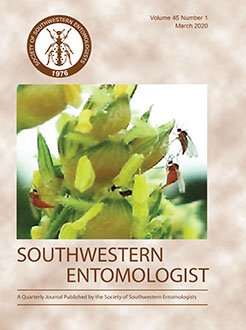The fall webworm, Hyphantria cunea Drury, is a key insect pest of trees such as pecan, Carya illinoinensis (Wangenh.) K. Koch, and apple, Malus domestica Borkh., being difficult to control because of the silk web formed by the larval stage for protection. The objective of this research was to evaluate the effectiveness of Beauveria bassiana (Bals.-Criv.) Vuill. and Metarhizium anisopliae (Metchnikoff) Sorokin on webworm larvae. Three strains of each pathogen were collected from the Arteaga Coahila region, grown to concentrations of 1 × 108 to 1 × 104 CFU/ml, and inoculated on 4th-instar larvae under controlled conditions in a laboratory. Numbers of dead fall webworm were checked every 24 hours for 8 days. B. bassiana strains were most effective at controlling the pest at LT50 of 31.8 hours, while LT50 for M. anisopliae strains was 67.1 hours at a concentration of 1 × 108 CFU/ml.
How to translate text using browser tools
31 March 2020
Beauveria bassiana and Metarhizium anisopliae Parasitism of Fall Webworm, Hyphantria cunea Drury Larvae
Alejandro De La Cruz Armas,
Luis A. Aguirre Uribe,
Yolanda Hernández Hernández,
Ernesto Cerna Chavez,
Yisa Ochoa Fuentes,
Mariano Flores
ACCESS THE FULL ARTICLE

Southwestern Entomologist
Vol. 45 • No. 1
March 2020
Vol. 45 • No. 1
March 2020




